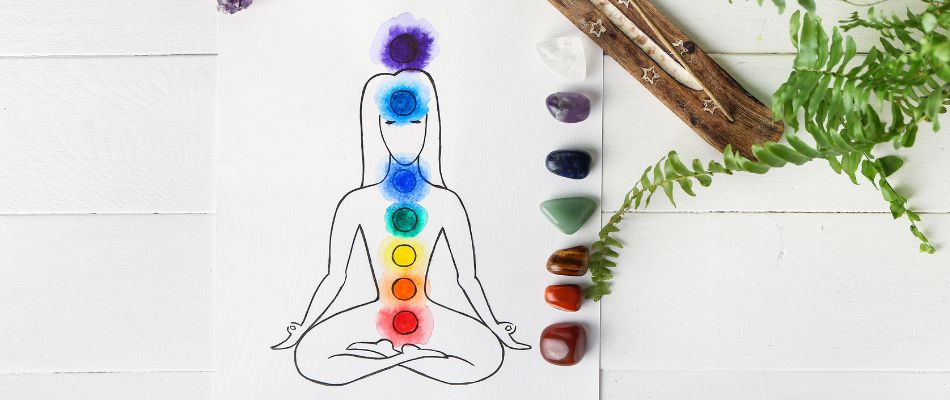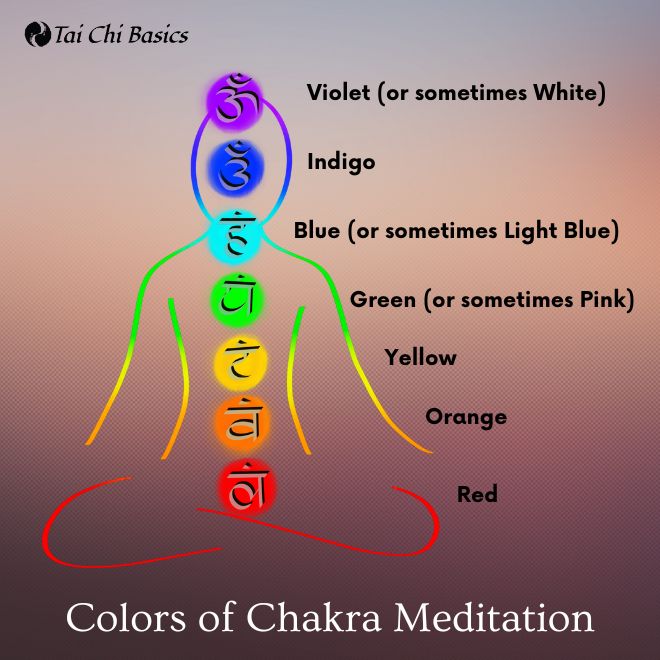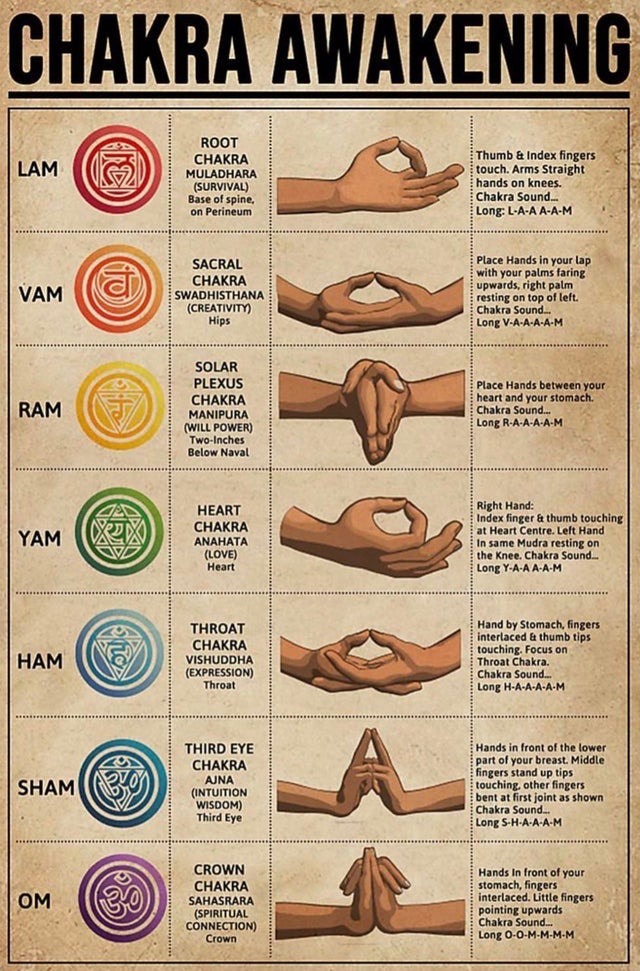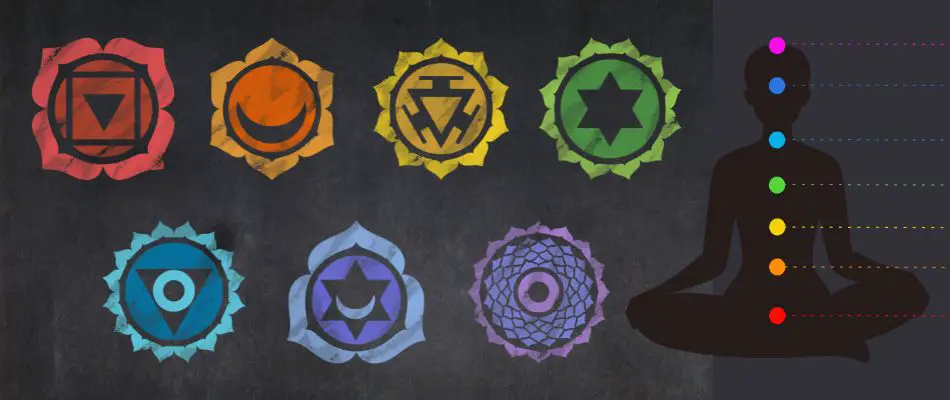My respect for chakra meditation has grown immensely over the years that I have been meditating but I have to tell you that this wasn’t always the case. I met very few people (me included) who could tangibly explain or demonstrate how meditating on the chakras could balance, align, or cleanse someone’s energy centers and improve their well-being. Then it became clear that chakra meditation is powerful, but requires a level of knowledge and commitment that I would say most of the available resources on chakra mediation don’t provide. And yet, here’s the truth:
Chakra meditation is the process of concentrating on seven energy centers in the body to improve mental and physical health. Originating in Hindu tradition, poor health is believed to result from a chakra or “wheel” being out of balance or blocked which the meditation works to correct.
Here’s what I plan to tackle in this essay: If you are an outsider investigating the chakra meditations for the first time, I think you will feel at home because I’ve organized my original research and am looking at the process through the lens of someone brought up on the dantian-based, Taoist approach to energy cultivation and meditation. They are not incompatible but deliver the results in theoretically different ways.
Secondly, chakra meditation is powerful but takes dedicated time and learning. I believe that a lot of the resources out there are well-intentioned but are doing the reputation a disservice by promising balance, alignment, or clearing of bad energy without including the steps, guided meditation or a script to back it up. So if you are diligent, read on. I will explain what mantra meditation is, walk through the seven chakra points, talk about the chakra meditation hand positions, colors, and guide you through chakra meditation.

What Chakra Meditation Is and Why Do Most People Fail to Get Results
I truly want you to be successful at chakra meditation but there is an elephant in the room that we need to acknowledge before we start: most people do not benefit from chakra meditation and abandon the practice. However, it has nothing to do with the meditation itself. If a person understands the process and why they are doing chakra meditation, they progress and are amazed. If they jump in without understanding the purpose, do not progress through the seven chakra points consistently, with the right intent, they fail to benefit from it and naturally stop.
Imagine feeling stress, constraint in your body, negative emotions, repetitive anxious thoughts, and having an immediate ability to reduce or stop it. Then, imagine feeling or experiencing less and less of this negativity over time, having a way to sense when you are overcome by it, and having a way to dissolve it. That’s the power of chakra meditation.
Chakra mediation isn’t just for people who have something obviously wrong going on in their lives. Negativity, even minor frustration, saps your energy, can make you less productive or wasting time on the wrong things. So even the highly productive among us become more focused on the things that count when we are aligned, feeling good and positive.
Why Do People Do Chakra Meditation?
There has been a resurgence in interest in chakra meditation for some really obvious reasons. For the most part, people perform chakra meditation with three goals in mind: to balance, align, or clear energy in the body. You can see with this vocabulary that it can be a single process just being described in slightly different ways. I feel that the guided chakra meditation at the end will accomplish this but there are some distinctions:
Chakra balancing meditation is described this way because it hints at the body possessing enough energy but that it is being used in the wrong area or in the wrong way. For example, you have a ton of work to do (focusing in the head) but are worried (stomach) about a loved one (heart). So a guided chakra balancing meditation would work to even this out.
Chakra clearing meditation hints at something that is blocking the flow of needed energy, depriving an area of needed resources. This description also makes a lot of sense because when things aren’t going right you actually feel a ton of tension in a part of your body that can’t seem to be relieved. For example, you could have a headache or “knots in your stomach.”
Chakra healing meditation alludes to some sort of damage that has been done that is going to require an active process or focus to return to a natural state. The caveat with this description is that you concretely know what has happened in your past or what you suffer from and are working to support your system to get past it.
No description is wrong and I think it really comes down to what resonates the most with you. What each description shares is that chakra meditation is the process of returning the body to a natural state where it can effectively use and respond the body’s needs.

What Chakra Meditation Actually Is and How it Is Performed Correctly
I would like to put my personal experience up against a lot of the available information on chakra meditation with the goal of giving you a greater leap forward than what I experienced. I unfortunately received only part of the instruction which I eventually pieced together over time. I didn’t experience anything akin to what others were saying happens during chakra meditation. Now, when I read back over some experiences that are shared by practitioners and what they say to do, I am not sure how they got their results if they are not including all of the pieces.
In my experience, there is a singular focus (goal) across the meditation and three specific things need to be completed at each position.
The 5 Correct Steps to Perform Chakra Meditation
- Sit or lay comfortably
- Meditate on each of the seven chakras moving from the bottom to the top
- Your entire goal is to relax and release tension in that part of the body
- On each chakra:
- Imagine the chakra spinning clockwise
- Focus on the color assigned to the chakra
- Hold your hands in the specific mudra (shape) assigned to the chakra
- Close the meditation by meditating on the entire chakra system and/or the entire body
There is some literature that suggests sounds at specific frequency could and should be used at each chakra. There is some logic here as it is believed that the colors, which are vibrations at specific frequencies, enhance the meditation. However, meditation with specific sound frequencies is not part of the original literature so I am not sure that there is any causal benefit. New research is trying to use these sound frequencies to combat noise pollution so we might see advances in the future.
Should you focus on one specific chakra or all of them in a single meditation?
The second debate out there is whether you should focus on specific meditation chakras or do the entire set. Here is the thinking on the single-chakra approach: Each chakra center addresses a specific energy. For example, a heart chakra meditation script would focus on love or a solar plexus chakra meditation script could focus on reducing anxiety. Therefore, if you are having problems in a specific area, focus on releasing blockage or balancing that area. Secondly, these meditations are shorter so they are easier to fit into our schedule.
The other school of thought believes that focusing on a single chakra misses the point. The whole goal is balance, therefore what you think is your problem might not be everything. By focusing on the whole system, we gain balance everywhere. An apt metaphor is going in for a massage because your shoulder hurts. The massage therapist wouldn’t just massage your shoulder, they would release tension throughout the back and chest to cause relief of tension in the shoulder, as well as focusing on the shoulder.
Here’s where I come down: It’s best to learn the entire system including the placements, colors, and mudras. Performing chakra meditation frequently reduces many of the specific problems. By learning the whole set, you are gaining seven tools that can then be used for specific problems. Let’s say you are going into a stressful interview, meditate on your chest. Let’s say you lose a loved one, meditate on your heart chakra. But this doesn’t work the other way around. You can’t only meditate on a specific chakra each day, even if it is how you are suffering the most, and expect a sense of balance.

The Seven Energy Centers of Chakra Meditation
Hopefully it’s clear by this point that a bit of knowledge is needed on the front end, well before someone does chakra meditation. It’s not overly complicated and we are really fortunate in this modern era to have access to clear concise information from experts around the world. For most westerners, an extra first step is needed to understand some of the history and science behind why the chakra system was even developed. Then an explanation of the energy points and how to use them in chakra meditation becomes more understandable.
Here is a really good primer on the chakras through a YouTube channel that focuses on presenting the original ideas of Hinduism and written in the Sanskrit texts. Let’s start with the logic and purpose behind the development of the chakra system and then the basics of where the points are and what an does an amazing job at explaining the chakras
An Explanation of the Existence of the Seven Chakras
A 5-Minute Explanation of the Seven Chakras and their Meanings
The Seven Chakras
The concept of chakras is deeply rooted in ancient Hindu philosophy, particularly within the realm of Kundalini Yoga and Tantric traditions. The word “chakra” itself is derived from the Sanskrit word for “wheel” or “disk,” signifying the dynamic, spinning nature of these energy centers. Hinduism teaches that the human body is a microcosm of the universe, and within it lies a vital life force known as “prana.” This prana flows through the body’s energy channels, known as “nadis,” and is concentrated within the chakras. The seven major chakras are believed to be crucial for harmonizing one’s physical, mental, and spiritual well-being.
What I really like about this system and where I think the real value of chakra meditation lies is that it gives us a framework for working our way through the body. We start at the base where the most powerful energy is and work up to the top of the head. The energy of each chakra is different, starting with the very strong, full energy associated with reproduction, transitioning through emotionally charged energies of the heart, and ending with thinner, more cognitive energy associated with thinking.
1. Muladhara (Root Chakra Meditation)
Location: The base of the spine, near the coccyx.
Energy: Muladhara represents our foundation and is associated with feelings of safety, security, and survival. It embodies the element of Earth and governs our basic needs, such as food, shelter, and a sense of belonging.
Root chakra meditation often targets a lack of motivation, fatigue, or exhaustion often associated with burnout.
2. Svadhisthana (Sacral Chakra Meditation)
Location: Located in the lower abdomen, just below the navel.
Energy: Svadhisthana is linked to our emotional well-being, creativity, and sensuality. It is associated with the element of Water and represents our capacity to enjoy life, explore our desires, and form healthy relationships.
One purpose of sacral chakra meditation is to increase creative energy and is helpful during times in life when we feel detached or uninvested in our work or activities in life.
3. Manipura (Solar Plexus Chakra Meditation)
Location: Situated in the upper abdomen, between the navel and the ribcage.
Energy: Manipura is the center of personal power, self-esteem, and willpower. It embodies the element of Fire and governs our sense of self-worth, confidence, and the ability to take action.
The benefits of solar plexus chakra meditation are an increased feeling of ease and comfort. People who suffer from anxiety that is accompanied by stomach pain or tightness in the abdomen have reported relief by focusing on the Manipura point.
4. Anahata (Heart Chakra Meditation)
Location: Found in the center of the chest, near the heart.
Energy: Anahata is associated with love, compassion, and forgiveness. It is the bridge between the lower and higher chakras, representing the element of Air and our capacity to give and receive love unconditionally.
Heart chakra meditation is by far the most common focus of all the energy centers as a balanced heart chakra results in increased feelings of love, ability to forgive others, connectedness, and facility with relationships, both the good and the bad.
5. Vishuddha (Throat Chakra Meditation)
Location: Positioned at the throat region.
Energy: Vishuddha governs communication, self-expression, and truth. It is linked to the element of Ether and represents our ability to convey our thoughts and emotions honestly and authentically.
The throat chakra meditation enables a person to speak clearly and communicate effectively.
6. Ajna (Third Eye Chakra Meditation)
Location: Located in the middle of the forehead, between the eyebrows.
Energy: Ajna is often referred to as the “third eye” and symbolizes intuition, insight, and spiritual awareness. It transcends the physical elements and connects us to our inner wisdom and higher consciousness.
Third eye chakra meditation is less about correcting something that may be deficient or not aligned and more about connecting to something greater and enhancing the positive attributes of the other chakras. Assuming that the chakra points below are open and full, a person can experience greater clarity, spiritual connection, becoming more self-aware, and even a connection or ability to focus on things around us leading to greater creativity or problem solving.
7. Sahasrara (Crown Chakra Meditation)
Location: Situated at the crown of the head.
Energy: Sahasrara is the highest chakra and represents pure consciousness, enlightenment, and unity with the divine. It is associated with the element of Cosmic Energy and represents our connection to the infinite.
When it comes to balance, using the crown chakra meditation wisely is important. While many of the problems associated with the different chakras are talked about as deficiencies, too much energy in the crown chakra such as repetitive thinking and worry can manifest itself as headaches or dizziness. Correct crown chakra meditation like all the chakras has to do with balance. In this case that might mean a release of energy to come into alignment.
With knowledge of the chakras in place, the last two pieces are understanding which colors to focus on with each energy center and how to hold the hands.

Colors of the Chakra System
During chakra meditation, practitioners visualize these colors at their respective chakra locations. The intention is to bring awareness to each chakra, visualize it as a vibrant, spinning wheel of energy in the specified color, and focus on balancing and harmonizing its energy. This practice is believed to promote overall well-being, emotional balance, and spiritual growth.
It’s important to note that individual experiences with chakra meditation may vary, and some practitioners may prefer different colors or techniques that resonate with them personally. In the image and notes below I have included the primary colors and other colors that some systems have said relate better.
- Muladhara (Root Chakra): Red is associated with the base chakra as it represents grounding, stability, and a connection to the Earth.
- Svadhisthana (Sacral Chakra): Orange symbolizes creativity, sensuality, and emotional well-being, making it the color of the sacral chakra.
- Manipura (Solar Plexus Chakra): Yellow is linked to the solar plexus chakra, representing personal power, confidence, and willpower.
- Anahata (Heart Chakra): Green (or sometimes Pink) represents love, compassion, and healing. Some traditions also use pink to emphasize unconditional love.
- Vishuddha (Throat Chakra): Blue (or sometimes Light Blue) is the primary color of the throat chakra, signifying communication, self-expression, and truth. Light blue variations are also used to represent clarity.
- Ajna (Third Eye Chakra): Indigo is the color associated with the third eye chakra, representing intuition, insight, and spiritual awareness.
- Sahasrara (Crown Chakra): Violet (or sometimes White) symbolizes enlightenment, cosmic consciousness, and unity with the divine. White is also used to represent the highest spiritual connection.
Chakra Meditation Hand Positions or Mudras
And, one more time. Let’s run through the chakras from bottom to top and talk about the hand positions or mudras and then you will have the knowledge you need to do the meditation on your own. Each mudra corresponds to a specific chakra and is thought to help focus and direct energy to that specific point.
Root Chakra (Muladhara): Muladhara Mudra
Position with your hands resting on your lap, palms facing up. Join the tips of your thumbs and index fingers while keeping the other fingers extended and relaxed. This mudra is grounding and connects you to the Earth’s energy.
Sacral Chakra (Svadhisthana): Yoni Mudra
Place your hands on your lap with your palms facing up. Cross your fingers, intertwining them with the left thumb on top of the right thumb. Extend your other fingers outward. This mudra enhances creativity and emotional balance.
Solar Plexus Chakra (Manipura): Agni Mudra
Bring your hands to your stomach area. Join the tips of your thumbs and middle fingers while keeping the other fingers extended and relaxed. This mudra boosts self-confidence and willpower.
Heart Chakra (Anahata): Anahata Mudra
Place your hands on your lap, palms facing up. Bring the tips of your thumbs and pinky fingers together while extending the other fingers. This mudra promotes love, compassion, and connection.
Throat Chakra (Vishuddha): Matangi Mudra
Place your palms facing up on your lap. Interlock your fingers, keeping the left thumb under the right thumb. Extend the index fingers and press them together. This mudra enhances communication and self-expression.
Third Eye Chakra (Ajna): Hakini Mudra
Leave your palms facing up on your lap. Join the tips of all fingers, creating a steeple-like shape. This mudra stimulates intuition and insight.
Crown Chakra (Sahasrara): Crown Chakra Mudra
Palms remain facing up on your lap. Touch the tips of your index fingers and thumbs to form a circle, keeping the other fingers extended. This mudra connects you to higher consciousness and spiritual awareness.
Here is a beautiful image that sums it up that was created by the Alaya Kolectiv which not only has beautiful meditation and home products but donates money they make to helping the planet. I have no relationship with them. Just wanted to share their efforts rather than recreate the wheel.

How is Chakra Meditation Different Than Other Practices?
In summary, chakra meditation is very different than other forms of meditation. Unlike mantra meditation or sound baths, chakra meditation can be enhanced by music and sound but is not dependent on it. Like Vipassana and Zen meditation, you are sitting quietly in contemplation but you are instead actively transitioning your focus through energy centers in the body. Like Loving Kindness and Insight Meditation, you are focusing on positive health transformations but it is not just a cognitive process.
Chakra meditation is a form of guided meditation most similar to Taoist meditations like the microcosmic orbit that also focus on the energy centers. In my experience, the goals of both meditations are health and improved living, but they come at it from completely different directions. Through qigong and meditations focusing on the dantians, a practitioner is working to actively increase the energy centers of the body with the idea that the body’s innate intelligence can then use this energy for what it deems to be the most important. This could be for healings, building, or even clear thinking. In Chakra meditation, the prevailing believe is that improved health comes from release of blockages of energy or from balancing energy centers. This is accomplished by relaxation and release of tension rather than actively building energy.



